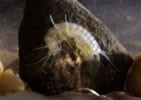The Protoctista Kingdom includes one celled and simple multicelled protozoa, slime moulds and algae.
Protozoans
These are minute one-celled organisms and include the simplest ‘animals’ such as amoeba, sporozoans and flagellates. Being unicellular (made up of only one cell), you will need a microscope to see them. They are present in large numbers yet have been little studied in caves. Some probably live in the caves and others are washed in.
Slime moulds
These strange things are amoeba-like during their feeding stage, and produce brightly coloured fungi when mature. They have characteristics of both plants and animals.
Algae
Green plants use the sun's energy to convert carbon dioxide into organic compounds such as sugar. The process is called photosynthesis and is carried out by green plants, algae and many bacteria. Some free living algae are found deep in caves and some have an absence of chlorophyll. These algae use non-photosynthetic metabolic pathways to survive without light. Many species exist in the soil. Organic matter in water can be used as a substitute for photosynthesis by algae.
Some of these micro-organisms (algae, bacteria and small fungi) are eaten by cave insects, others may live inside the insect digestive system, both enabling the cave insect to survive in an environment where food is scarce.
A slippery brownish coating on the rocks in mountain streams is due to a group of algae called diatoms, in addition to their green pigment they also have a yellow sunlight-gathering pigment. Diatoms include both autotrophs and heterotrophs. When organisms such as diatoms die the turbulent water in the streams creates foam from the natural compounds and oils. This is often left on walls and ceilings as a good indicator of recent flooding.
Higher Plants
Higher plants (higher refers to their more advanced structure rather than height) need sunlight and are only found above ground, consequently they are limited to the threshold zone of caves, although roots can be seen deeper into the cave if the passage lies sufficiently close to the surface. Plants have a chemical (a bit like chlorophyll) that switches its formula depending on light intensity. If light is low it exists in a form that prompts the plant to grow taller in an effort to reach more light (this is why seedlings in caves are often tall and spindly with a token leaf at the top).
Near the lights in show caves you may see the ferns Maidenhair Spleenwort, Brittle Bladder Fern and Hart’s Tongue Fern as well as mosses and cyanobacter.
|



